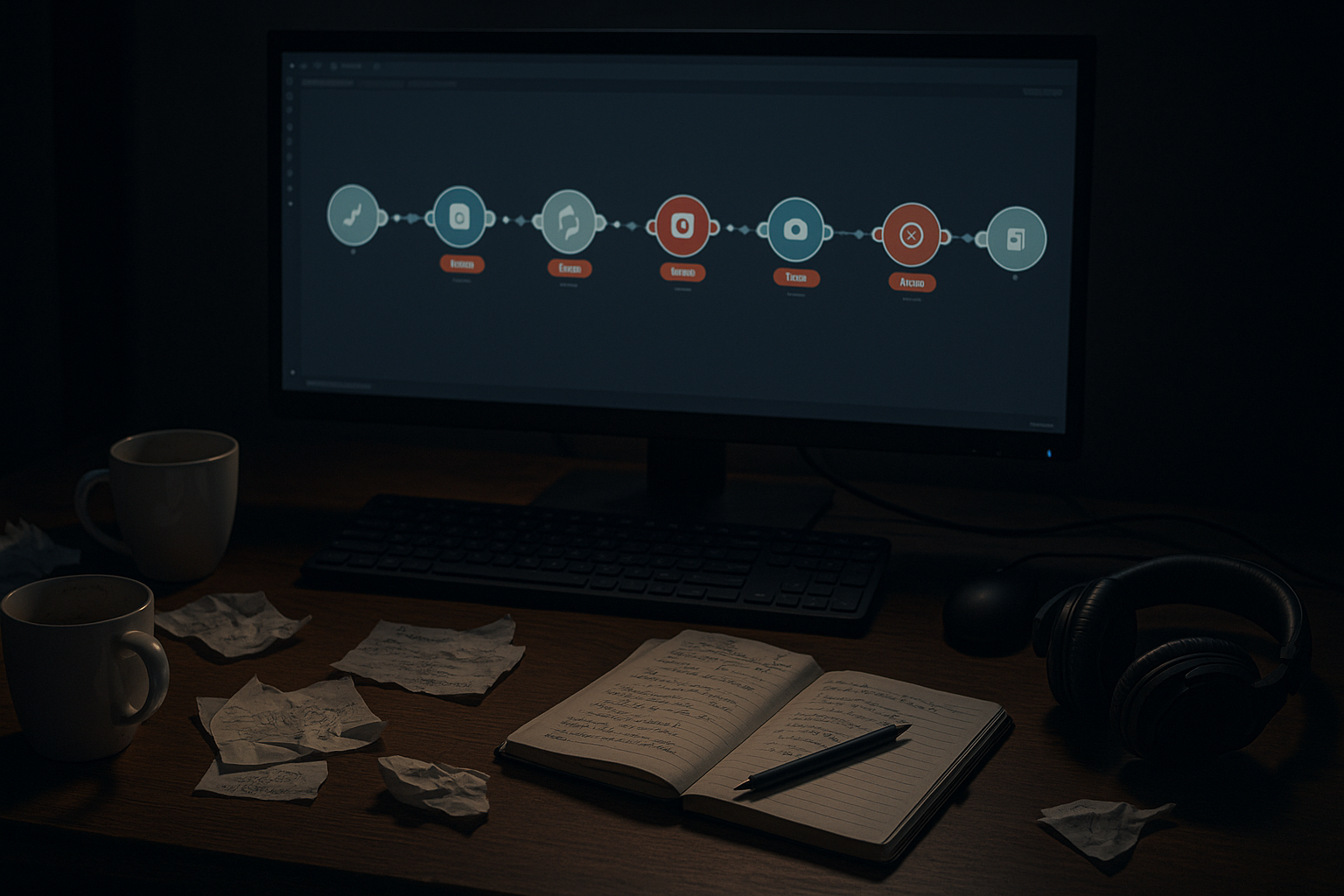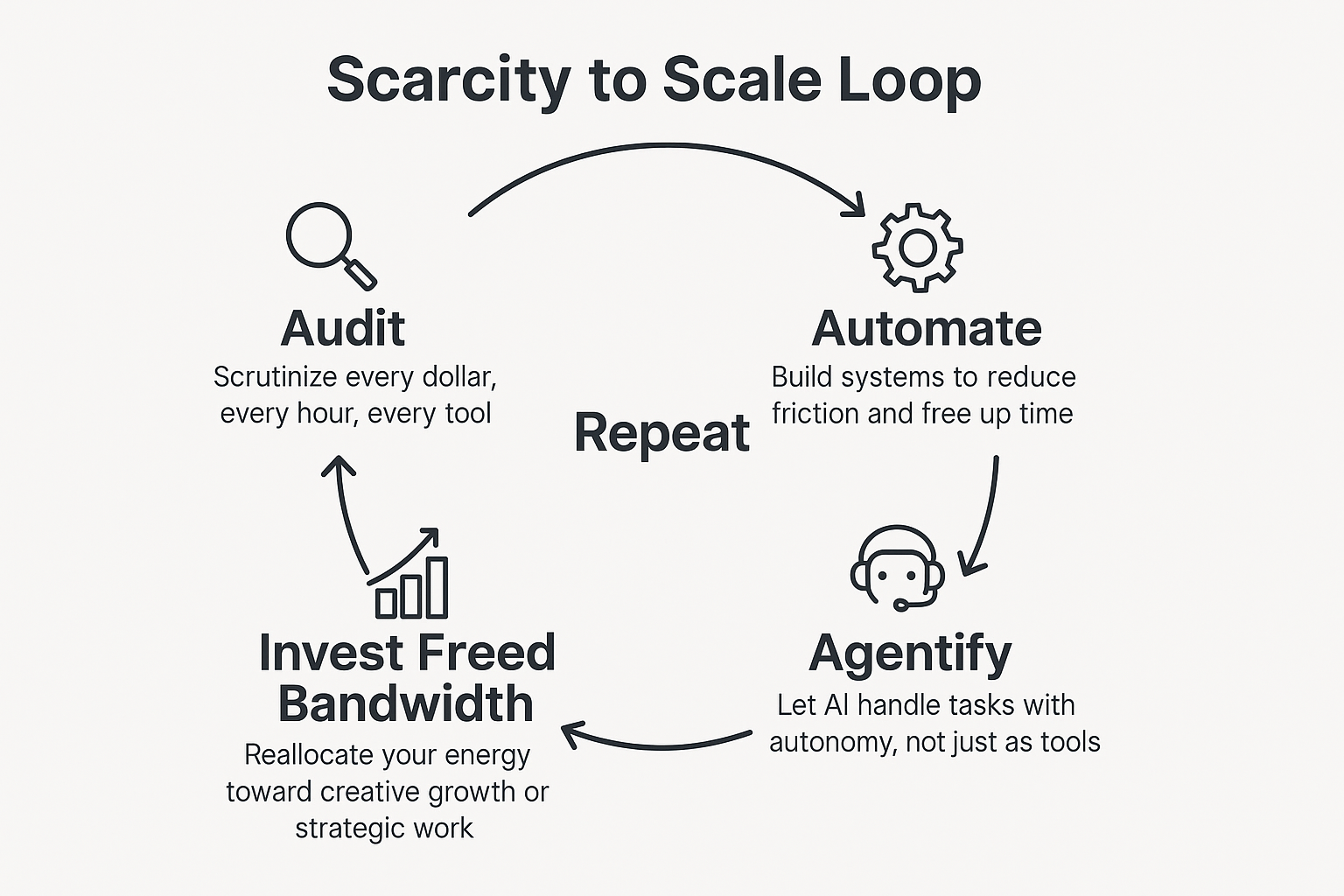#002 : Bootstrapping, Burnout & the Scarcity Super-Power


June 20, 2025






Day 5 of trying to automate personalized customer onboarding journeys, and my brain feels like it’s melted at least twice this week. I’ve deleted probably a dozen Make scenarios already, though three of them finally seem promising enough to survive another day. Have I automated everything I set out to? Not even close. But after hours of late-night debates with Claude Sonnet 4—prompting, testing, failing, tweaking—I’ve at least convinced myself that it’s possible. I haven’t fully cracked the code yet, but each small win feels like real progress.
It’s funny—I keep seeing these polished Instagram and LinkedIn posts promising seamless automation in “one click” or with some magical tool. The reality, though, is never that simple. Automation isn’t a single tool or a neatly packaged workflow. It’s messy, iterative work—planning, testing, breaking, fixing, and doing it all again until the edges finally smooth out.

Back at Microsoft, solving this kind of problem meant opening Teams and instantly having access to specialists. Whether you needed someone to design a customer lifecycle, troubleshoot data flows, or explain the intricacies of automation tools., you had resources everywhere andalways within reach. It’s not that I became entirely dependent on that abundance, but two decades in that comfortable corporate world certainly softened my scrappy muscles.
Subscribe now to unlock the full article and gain unlimited access to all premium content.
SubscribeDay 5 of trying to automate personalized customer onboarding journeys, and my brain feels like it’s melted at least twice this week. I’ve deleted probably a dozen Make scenarios already, though three of them finally seem promising enough to survive another day. Have I automated everything I set out to? Not even close. But after hours of late-night debates with Claude Sonnet 4—prompting, testing, failing, tweaking—I’ve at least convinced myself that it’s possible. I haven’t fully cracked the code yet, but each small win feels like real progress.
It’s funny—I keep seeing these polished Instagram and LinkedIn posts promising seamless automation in “one click” or with some magical tool. The reality, though, is never that simple. Automation isn’t a single tool or a neatly packaged workflow. It’s messy, iterative work—planning, testing, breaking, fixing, and doing it all again until the edges finally smooth out.

Back at Microsoft, solving this kind of problem meant opening Teams and instantly having access to specialists. Whether you needed someone to design a customer lifecycle, troubleshoot data flows, or explain the intricacies of automation tools., you had resources everywhere andalways within reach. It’s not that I became entirely dependent on that abundance, but two decades in that comfortable corporate world certainly softened my scrappy muscles.
Six months into bootstrapping two businesses, those muscles are coming back to life, and just like going to the gym after a long break, everything hurts. The soreness is real. Every subscription I buy now faces intense scrutiny; every freelance hour gets carefully scoped; every expense demands a thorough research session before it earns a place on my credit card. It’s uncomfortable, but I recognize it’s exactly this discomfort that makes me sharper. Scarcity, it turns out, is a real superpower—if you can learn how to wield it.
Today, scarcity driven automation isn’t just convenient, it’s essential. But automation brings a heavy cognitive load. Most of my time is spent thinking about how to automate something, or even automate the automation itself—the meta-layer. The irony isn’t lost on me: automation is supposed to reduce mental overhead, yet building these systems requires relentless, exhausting cognitive effort. Burnout feels dangerously close some days, especially when the solutions that promise relief end up doubling the workload. Last Month, I hit a wall—pushed myself too hard, too long, and paid the price. I admit, while working on multiple things, i am not great at taking breaks, this is another muscle that needs strengthening.
Yet, the necessity to stay scrappy leads directly to creativity. In April, Make.com suddenly retired their Twitter ("X") integration, breaking all of my scenarios that monitored tweets. My immediate thought was that I'd have to move my entire setup to another no-code platform—an expensive, painful, time-consuming task. But bootstrapped instincts quickly kicked in: there had to be another way. Two intense hours spent bouncing ideas with GPT-4o and the Replit agent later, I had a simple Flask app doing precisely what Make's retired module once did, it fetched tweets and seamlessly piped the data back into a Make webhook. The result? No expensive migrations, no rebuilding scenarios from scratch, and total monthly cost under $10 for a solution running reliably, 24/7. The biggest payoff wasn't even the money, it was rediscovering my own resourcefulness and remembering how satisfying it feels to quickly hack together an elegant solution.

When things start feeling overwhelming, I lean on a simple loop that’s quickly become second nature to me:
The Scarcity-to-Scale Loop
- Audit: I list every recurring task, cost, and mental nag.
- Automate: The obvious ones become Make modules or quick scripts.
- Agentify: Mature tasks get handed off to GPT routines with careful guardrails.
- Invest Freed Bandwidth: Every reclaimed hour or dollar immediately feeds the next meaningful experiment.
Then I repeat—before comfort settles back in—because comfort is exactly where scarcity stops being useful and starts to weigh you down again.

There's an intriguing idea floating around online—the notion of the world's first billion-dollar, one-person company. It’s tempting to imagine automating over 90% of your business, scaling through code and agents alone, maintaining fat margins and total control. But when I really stop and think about it, I see a glaring reality check: someone has to decide exactly what to automate, determine exactly how an AI agent makes decisions, and recognize precisely when to scrap a workflow that’s quietly rotting in the background. These decisions have a cognitive cost—and bandwidth is always finite. Maybe in the future, AI tools get better to where autonomy is a single click away and context is omnipresent, but as of today, meta-automation takes significant planning and work.
To be clear, becoming a billion-dollar solo founder isn’t a personal north star for me. In reality, there are very few industries where that's even possible. But the pursuit of it—the sheer audacity required—genuinely fascinates me. It's this pursuit that pushes one to master scarcity, automation, and intelligent use of artificial resources. Developing that skill, building that muscle, is my real north star. It remains to be seen if that muscle can bulk up fast enough to outrun burnout, but the challenge itself keeps me energized. For now, I'll keep training—planning, building, automating, breaking things, and then doing it all over again tomorrow.


.svg)